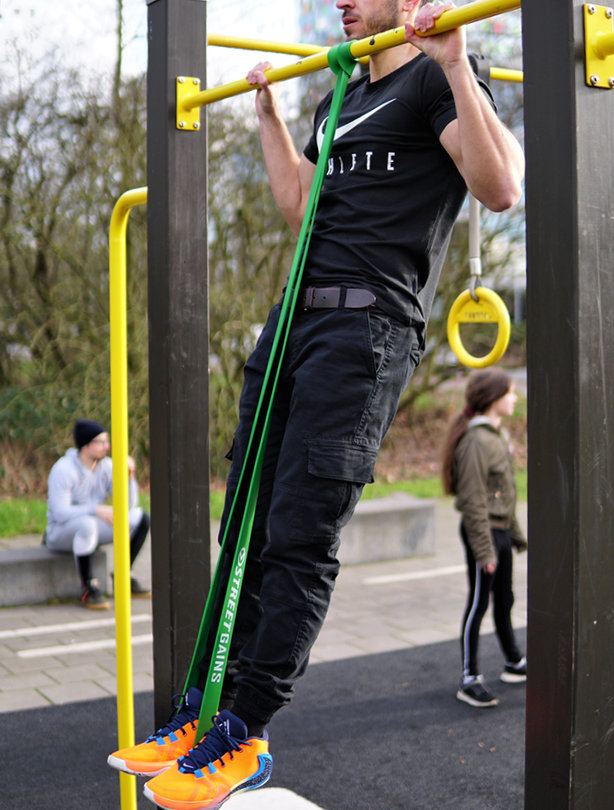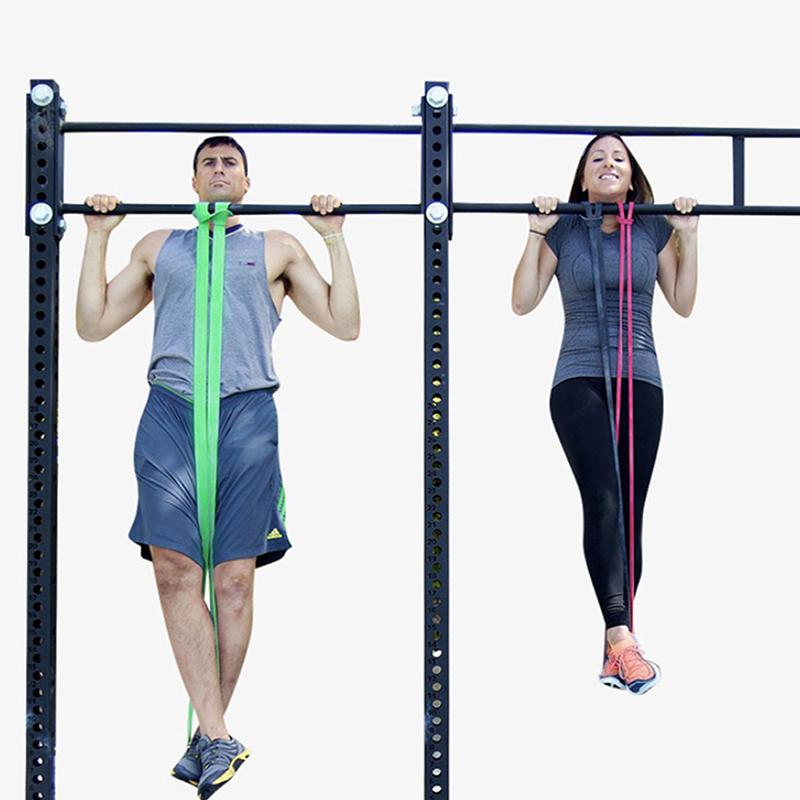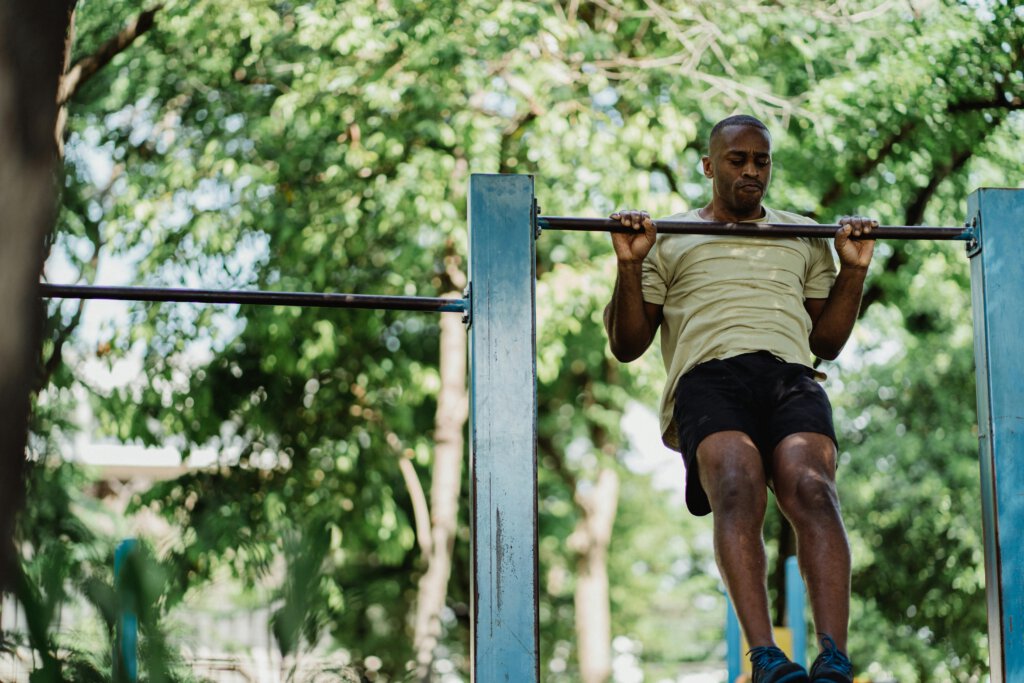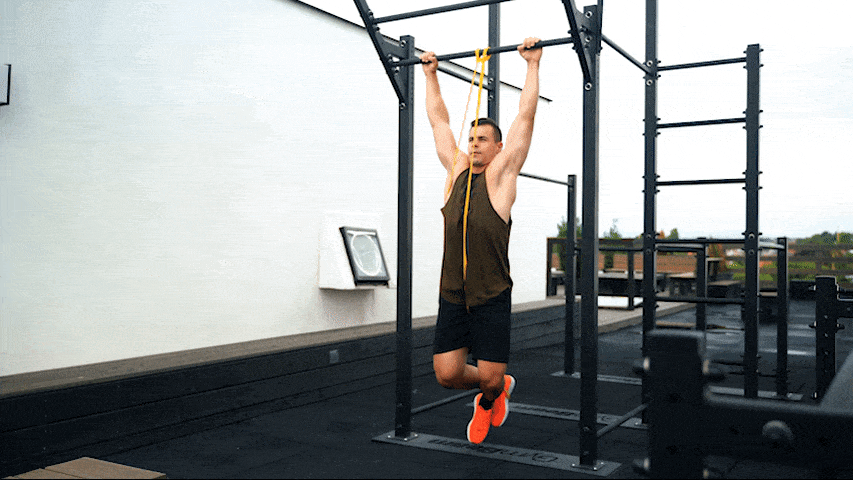How to start pull-ups with bands for calisthenics beginners
Pull-ups are one of the most effective calisthenics exercises but are also a movement that feels impossible for beginners. Fact: Studies show that few people In fact 20% of people can perform a pull-up. And that’s where resistance bands factor in.
Bands are a great way to lighten the load, so that beginners can ease into pull-up training by building strength, honing perfect form and confirming confidence, before they take the next step to unassisted pull-ups.
In this article you will find out how to use resistance bands to do a pull-up: step-by-step, the best band set-up, mistakes to avoid and a 4-week program to get your first pull-ups. With a little patience and the proper approach, anyone can begin to successfully start their pull-up journey.
Why use bands for pull-up training
Many beginners wonder if band assisted pull ups actually work or if they’re just a gimmick. The truth? Bands are one of the most effective tools for beginner pull up progression. They allow you to reduce body weight load, practice proper form, and build strength step by step without getting frustrated, hurting yourself or risking injury.
One mistake people often make is grabbing the heaviest band possible and banging out reps without really engaging the muscles. That just turns into bouncing up and down, which doesn’t translate to unassisted pull-ups, and before you can do regular pull-ups you must build the strength with a resistance band. What you really want is a band that gives just enough help so you can feel the movement but still work for it.
“Strength does not come from physical capacity. It comes from an indomitable will.” – Mahatma Gandhi
As with many beginners they finally hit their first real pull-up simply because they spent time on resistance band pull ups. Bands let you feel the mechanics,, keeping confidence that you can do a pull-up, and make training fun instead of discouraging and hard. Pull-ups are not easy, they are hard even for people who go to the gym regularly.
Takeaways
- Bands reduce body weight, letting you learn mechanics safely.
- Too strong of a band means no progress, you just bounce up and down.
- Best way to build confidence before an unassisted pull-up.
Choosing the right resistance band for pull-ups
Not all pull up assistance bands are created equal. If you pick the wrong one it can hold you back. Light, medium, and heavy bands all have their place in a beginner pull up progression, but the trick is matching the band to your current strength level.
Different band resistance levels
- Light bands: Best for finishing sets, endurance work, or advanced lifters.
- Medium bands: Ideal for most beginners starting out.
- Heavy bands: Good for those who can’t pull body weight at all yet.
How to select the right band
A common mistake is using the same band for months without moving to a lighter one. If you’re doing sets of 12–15 banded pull up workouts easily, you’re overdue for a smaller band. That’s when you actually build pulling strength.
Durability and brands
Durability also matters. Cheap bands can snap mid-rep, and trust me, that’s not fun, it really hurts for both men and women. Look for layered latex or brands with a good rep for longevity. Progressive resistance is key in strength development, and bands provide exactly that.

For anyone serious about training, a Pull-Up resistance band is totally worth it.
Takeaways
- Light means good for finishing sets, heavy means better for beginners.
- Progress by moving to lighter bands as you get stronger and do more reps.
- Pick bands you can progress with, not just the heaviest ones.
- Cheap bands can snap; invest in more durable options.
- Resistance progression is what builds real pull-up strength.
Proper technique for band-assisted pull-ups
Learning how to do pull ups with bands the right way makes all the difference. To get started first, loop the band securely over the bar and double-check that it’s not sliding. Then choose either foot placement (band under one or both feet) or knee placement (band behind the knee). The foot gives more assistance, with the knee it feels closer to a real pull-up.

Foot vs. knee placement
- Foot in band means more help, smoother motion.
- Knee in a band means less help, closer to the real feel of a pull-up.
Engaging the right muscles
The big mistake here? Letting the band control you instead of controlling the movement. Your lats, shoulders, and core should stay tight the whole time. Think about pulling your elbows down to your sides, not just throwing your chin over the bar haha.
Breathing tips
Breathing helps too. Exhale as you pull up, inhale as you lower. A lot of beginners hold their breath and end up gassed halfway through the set.
Watch these videos that break it down step by step:
Takeaways
- Band under foot means more help, band under knee means closer to real pull-up.
- Keep lats, shoulders, and core engaged throughout.
- Exhale on the pull, inhale on the lower.
- Don’t let the band throw you around.
Common mistakes to avoid with band pull-ups
When learning resistance band pull ups, most beginners mess up by relying too much on the band’s rebound. Instead of actually working the lats, they spring up like a trampoline.
The biggest mistakes beginners make
- Half reps: chin never clears the bar or arms don’t fully extend. Always aim for full range of motion.
- Skipping scapular retraction: without pulling shoulder blades down and back, you’ll never engage the lats properly. Don’t bounce with the band; control every rep.
- Wrong band resistance: too strong makes it too easy, too weak makes it impossible. Match band strength to your current ability.
Remember, consistency with proper form is what gets results. It’s not about cranking out numbers, it’s about building mechanics.
Alternative progressions for beginners
If you’re stuck on resistance bands forever, you’ll hit a wall. That’s where alternative pull up progressions come in. There are other types of pull-ups too, here is a list of the variances with a short explanation of how to do it.
- Negative pull-ups (eccentric training): Jump to the top and lower slowly for 5–8 seconds. That eccentric work builds serious pulling power. Eccentric training is one of the fastest ways to improve strength, even though it doesn’t seem like it.
- Isometric holds: Hold your chin above the bar, halfway up, and even at the bottom. It’s brutal but builds control.
- Australian pull-ups: Also called body rows, these are amazing for working pulling volume without frying your grip.
- Grip strength work: Weak grip = no pull-ups. Farmer carries, towel hangs, or even thick bar training all help.

Takeaways
- Negative pull-ups means best strength builder.
- Isometric holds improve control at all ranges.
- Australian pull-ups add volume safely.
- Grip strength work speeds up pull-up progress.
- Gradual drop in band assistance improves strength.
4 week beginner-friendly pull-up plan with bands
Here’s a pull up progression plan that’s realistic and sustainable. Training three days a week (e.g., Mon, Wed, Fri) keeps you consistent but gives room for recovery. Rest days should focus on mobility and light cardio so your shoulders stay healthy. With 3 training days weekly you get enough exercise as a beginner.
Week 1
- 4 sets x 6–8 assisted pull-ups (medium band)
- 3 sets x 20s isometric holds at top
- 3 sets x 10 scapular pull-ups
Week 2
- 4 sets x 8–10 assisted pull-ups (medium band)
- 3 sets x 5 eccentric pull-ups (5-sec lowering)
- 3 sets x 15 inverted rows
Week 3
- 5 sets x 8 assisted pull-ups (lighter band if possible)
- 3 sets x 25s top holds
- 3 sets x 12–15 scapular pull-ups
Week 4
- 5 sets x 8–10 assisted pull-ups (lighter band)
- 3 sets x 5 eccentric pull-ups
- 3 sets x max inverted rows
- Test unassisted pull-up at end of week
Tips for faster progress in calisthenics
To speed up pull-up gains, track progress weekly. Write down reps, band color, and how each set feels. That small habit makes a huge difference in motivation.
Track and balance
Balance is key too. Pair your pull-up bar workout for beginners with pushing moves like push-ups or dips. If you only pull, your shoulders will get cranky.
Recovery and nutrition
Recovery is underrated. Sleep 7–9 hours, eat enough protein, and stay hydrated. Without recovery, strength won’t stick.
When to go band-free
Transition to unassisted pull-ups once you can do 8–10 clean reps with the lightest band. Don’t wait forever because at some point you’ve got to go without it :) Progress is rarely a straight line. It’s a zigzag of effort, rest, and persistence.
A simple training log notebook is underrated but powerful. Writing down your sessions keeps you honest and helps you spot when it’s time to level up.
Takeaways
- Track workouts weekly for motivation.
- Balance pull-ups with pushing exercises.
- Recovery (sleep, food, hydration) = progress.
- Switching to unassisted bands once the lightest band feels easy.
Conclusion
Starting pull-ups with resistance bands is one of the smartest ways for calisthenics beginners to break through the initial barrier of strength. Bands not only make the movement accessible but also build the foundation needed for unassisted pull-ups.
Remember consistency beats intensity. Stick with the plan and progress slowly, and celebrate each rep along the way, pull ups are not easy! In a few weeks what might feel impossible will become part of your training routine. Grab a band and start today.


